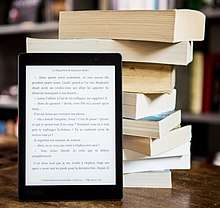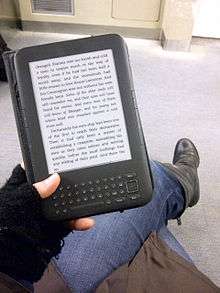E-reader

An e-reader, also called an e-book reader or e-book device, is a mobile electronic device that is designed primarily for the purpose of reading digital e-books and periodicals.[1]
Any device that can display text on a screen may act as an e-reader, but specialized e-reader devices may optimize portability, readability (especially in sunlight), and battery life for this purpose. Their main advantages over printed books are portability since an e-reader is capable of holding thousands of books while weighing less than one and the convenience provided due to add-on features in these devices.[2]
Overview

An e-reader is similar in form factor to a tablet computer.[3] E-readers are a convenient way to read e-books since the battery can last for several weeks, compared to a laptop that usually needs daily battery charging; in addition an e-reader does not have apps that may distract its user from reading.[4]
The main advantages of electronic paper e-readers are better readability of their screens, especially in sunlight, and longer battery life.[5]
The Sony Librie, released in 2004 and the precursor to the Sony Reader, was the first e-reader to use electronic paper.[6] The Ectaco jetBook Color was the first color e-reader on the market, but its muted colors were criticized.[7]
Many e-readers can use the internet through Wi-Fi and the built-in software can provide a link to a digital Open Publication Distribution System (OPDS) library or an e-book retailer, allowing the user to buy, borrow, and receive digital e-books.[8] An e-reader may also download e-books from a computer or read them from a memory card.[9] However, the use of memory cards is decreasing as most of the 2010s era e-readers lack a card slot.[10]
History
An idea similar to that of an e-reader is described in a 1930 manifesto written by Bob Brown titled The Readies,[11] which describes "a simple reading machine which I can carry or move around, attach to any old electric light plug and read hundred-thousand-word novels in 10 minutes". His hypothetical machine would use a microfilm-style ribbon of miniaturized text which could be scrolled past a magnifying glass, and would allow the reader to adjust the type size. He envisioned that eventually words could be "recorded directly on the palpitating ether".[12]
The establishment of the E Ink Corporation in 1997 led to the development of electronic paper, a technology which allows a display screen to reflect light like ordinary paper without the need for a backlight. The Rocket eBook was the first commercial e-reader[13] and several others were introduced around 1998, but did not gain widespread acceptance. Electronic paper was incorporated first into the Sony Librie that was released in 2004 and Sony Reader in 2006, followed by the Amazon Kindle, a device which, upon its release in 2007, sold out within five and a half hours.[14] The Kindle includes access to the Kindle Store for e-book sales and delivery.
As of 2009, new marketing models for e-books were being developed and a new generation of reading hardware was produced. E-books (as opposed to e-readers) had yet to achieve global distribution. In the United States, as of September 2009, the Amazon Kindle model and Sony's PRS-500 were the dominant e-reading devices.[15] By March 2010, some reported that the Barnes & Noble Nook may be selling more units than the Kindle in the US.[16]
Research released in March 2011 indicated that e-books and e-readers are more popular with the older generation than the younger generation in the UK. The survey carried out by Silver Poll found that around 6% of people over 55 owned an e-reader, compared with just 5% of 18- to 24-year-olds.[17] According to an IDC study from March 2011, sales for all e-readers worldwide rose to 12.8 million in 2010; 48% of them were Amazon Kindles, followed by Barnes & Noble Nooks, Pandigital, and Sony Readers (about 800,000 units for 2010).[18]
On January 27, 2010 Apple Inc. launched a multi-function tablet computer called the iPad[19] and announced agreements with five of the six largest publishers[20] that would allow Apple to distribute e-books.[21] The iPad includes a built-in app for e-book reading called iBooks and had the iBookstore for content sales and delivery. The iPad, the first commercially profitable tablet, was followed in 2011 by the release of the first Android-based tablets as well as LCD tablet versions of the Nook and Kindle; unlike previous dedicated e-readers, tablet computers are multi-function, utilize LCD touchscreen displays, and are more agnostic to e-book vendor apps, allowing for installation of muilple e-book reading apps. The growth in general-purpose tablet use allowed for further growth in popularity of e-books in the 2010s.
In 2012, there was a 26% decline in sales worldwide from a maximum of 23.2 million in 2011. The reason given for this "alarmingly precipitous decline" was the rise of more general purpose tablets that provide e-book reading apps along with many other abilities in a similar form factor.[22] In 2013, ABI Research claimed that the decline in the e-reader market was due to the aging of the customer base.[23] In 2014, the industry reported e-reader sales worldwide to be around 12 million, with only Amazon.com and Kobo Inc. distributing e-readers globally and various regional distribution by Barnes & Noble (US/UK), Tolino (Germany), Icarus (Netherlands), PocketBook International (Eastern Europe and Russia) and Onyx Boox (China).[24] At the end of 2015, eMarketer estimates that there are 83.4 million e-reader users in the US, with the number predicted to grow by 3.5% in 2016.[25] In 2014, The New York Times predicted that by 2018 e-books will make up over 50% of total consumer publishing revenue in the U.S. and UK.[26]
Until late 2013, use of an e-reader was not allowed on airplanes during takeoff and landing.[27] In November 2013, the FAA allowed use of e-readers on airplanes at all times if it is set to be in Airplane Mode, which means all radios turned off and Europe followed this guidance the next month.[28]
E-reader applications
Many of the major book retailers and third-party developers offer e-reader applications for desktops, tablets and mobile devices, to allow the reading of e-books and other documents independently of dedicated e-book devices.[29] The e-reader applications are available for the Mac and PC computers as well as for Android, iOS and Windows devices.
Impact
The introduction of e-readers brought substantial changes to the publishing industry, also awakening fears and predictions about the possible disappearance of books and print periodicals.[30]
Popular e-readers
- Amazon (Global): Kindle, Kindle Paperwhite, Kindle Voyage, Kindle Oasis, Kindle Oasis 2
- Barnes & Noble (US/UK): Nook, Nook GlowLight, Nook GlowLight Plus
- Bookeen (France): Cybook Opus, Cybook Orizon, Cybook Odyssey, Cybook Odyssey HD FrontLight
- Icarus e-reader (Netherlands): Omnia, Illumina and Excel
- Kobo (Global): Kobo Touch, Kobo Glo, Kobo Mini, Kobo Aura, Kobo Aura HD
- Onyx Boox (Europe and China): Onyx Boox Max2, Onyx Boox Note
- PocketBook (Europe and Russia): PocketBook Touch, PocketBook Mini, PocketBook Touch Lux, PocketBook Color Lux, PocketBook Aqua
- Tolino (Germany): Tolino Shine, Tolino Vision, Tolino Vision 2
See also
References
- ↑ "Best E-Book Readers of 2017". CNET. Retrieved 2017-05-26.
- ↑ Ray, C. Claiborne (October 24, 2011). "The Weight of Memory". The New York Times. Q&A (column). p. D2.
- ↑ And the most popular way to read an e-book is. Wired. November 2010.
- ↑ The one gadget I can’t live without… is not my phone Techzim. Retrieved May 17, 2017
- ↑ Falcone, John (July 6, 2010). "Kindle vs. Nook vs. iPad: Which e-book reader should you buy?". CNet. Retrieved January 26, 2013.
- ↑ "Sony LIBRIe – The first ever E-ink e-book Reader". Mobile mag. 2004-03-25. Retrieved 21 March 2013.
- ↑ "Ectaco jetBook Color E-ink reader". Trusted Reviews. Retrieved June 17, 2013.
- ↑ "How to Rent or Borrow eBooks Online". www.moneycrashers.com. Retrieved 2017-05-26.
- ↑ "Everything You Need to Know About Using a MicroSD Card With Your Amazon Fire Tablet". Retrieved 2017-05-26.
- ↑ "Will Memory Cards Be Phase Out for eReaders Altogether? | The eBook Reader Blog". Retrieved 2017-05-26.
- ↑ Brown, Robert "Bob" (2009). Saper, Craig J., ed. The Readies. Literature by Design: British and American Books 1880–1930. Houston: Rice University Press. ISBN 9780892630226. OCLC 428926430. Retrieved 2012-12-06.
- ↑ Schuessler, Jennifer (2010-04-08). "Bob Brown, Godfather of the E-Reader". The New York Times. Retrieved 2012-12-06.
- ↑ MobileRead Wiki – Rocket eBook. Wiki.mobileread.com (2011-11-20). Retrieved on 2012-04-12.
- ↑ Patel, Nilay (November 21, 2007). "Kindle Sells Out in 5.5 Hours". Engadget.com. Archived from the original on November 23, 2007. Retrieved November 21, 2007.
- ↑ Take, First (2010-09-11). "Bookeen Cybook OPUS | ZDNet UK". Community.zdnet.co.uk. Retrieved 2011-10-24.
- ↑ Rodney Chan Nook outnumbers Kindle in March, says Digitimes Research, DIGITIMES, Taipei, 26 April 2010
- ↑ "E-book popularity set to increase this year". Retrieved 4 March 2011.
- ↑ "Nearly 18 Million Media Tablets Shipped in 2010 with Apple Capturing 83% Share; eReader Shipments Quadrupled to More Than 12 Million" (Press release). IDC. 10 March 2011. Archived from the original on 2014-10-28.
- ↑ "iPad – See the web, email, and photos like never before". Apple. Retrieved 2011-10-24.
- ↑ "iPad iBooks app US-only, McGraw-Hill absent from Apple event". AppleInsider. January 28, 2010. Retrieved February 14, 2010.
- ↑ "Apple Launches iPad". Apple.com. 2010-01-27. Retrieved 2011-10-24.
- ↑ Tibken, Shara (December 12, 2012). "RIP e-book readers? Rise of tablets drives e-reader drop". CNet.
- ↑ Smith, Tony (25 January 2013). "Tablets aren't killing e‐readers, it's clog-popping wrinklies – analyst". The Register.
- ↑ The State of the e-Reader Industry in 2015 September 24, 2015
- ↑ Many Thought the Tablet Would Kill the Ereader. Why It Didn't Happen. eMarketer, February 29, 2016. Retrieved 1 March 2016.
- ↑ "In Europe, Slower Growth for e-Books". The New York Times (2014-11-12). Retrieved on 2014-12-05.
- ↑ Matt Phillips (2009-05-07). "Kindle DX: Must You Turn it Off for Takeoff and Landing?". The Wall Street Journal. Retrieved 2011-07-28.
- ↑ "Cleared for take-off: Europe allows use of e-readers on planes from gate to gate". The Independent. London.
- ↑ "How to buy the best ebook reader - Which?". www.which.co.uk. Retrieved 2017-05-26.
- ↑ Ballatore, Andrea; Natale, Simone (2015-05-18). "E-readers and the death of the book: Or, new media and the myth of the disappearing medium". New Media & Society: 1461444815586984. doi:10.1177/1461444815586984. ISSN 1461-4448.
External links

